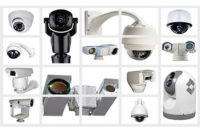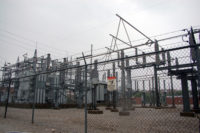Like many utility companies around the country, City Utilities in Springfield, Mo., was the victim of copper theft. To protect the substations, security cameras were a must. However, providing the lighting for the cameras posed a problem.
“We have substations in rural areas but also some of our substations are in communities and near houses,” explains Nick Rasey, manager of physical security with City Utilities. The lighting needed for security cameras would have been a disturbance in these neighborhoods, and Rasey says City Utilities didn’t want to be a bad neighbor. So he decided to turn to thermal cameras from Axis Communications.
“With the thermal cameras, we don’t have to adjust the lighting at all to keep the neighbors happy,” he says. “And we can use the thermal cameras to see if the image is a human or a cow or deer or dog, so we can authenticate the alarm.”
Being able to tell if it is a human rather than an animal, Rasey says they are able to make more informed calls on when to dispatch security personnel or to call in police. “False alarms are a big problem. People don’t like it when you are constantly crying wolf, and that creates a lesser chance of response. We wanted to cut out the false alarms.”
Originally thermal cameras were used primarily by the military. However, recent developments in thermal-camera processing have taken video intrusion detection to a whole new level with clearer thermal images and unparalleled video analytic accuracy. And today, thermal cameras are available to more businesses and property owners because they have become less cost prohibitive. According to John Romanowich, CEO with SightLogix, thermal detection cameras are now on par in cost per foot with traditional approaches to perimeter security.
But as Rasey points out, thermal cameras can save a company money, as well. City Utilities installed the first thermal cameras at the beginning of 2012 in response to a rash of break-ins. “In a 22 day period, we had nine break-ins with about $45,000 worth of replacements,” Rasey says. Thieves, he adds, were after the copper wiring.
You can put a dollar figure on theft, but you can’t put a dollar figure on human life. Adding the thermal cameras was as much about life safety issues as it was about theft prevention. “There are people who die from getting into substations and cutting wire,” Rasey says. “But also there is the situation of an employee going into a substation when we don’t know there has been a theft.”
City Utilities has 50 substations and all are now equipped with thermal cameras. Within two weeks of the initial rollout, Rasey says they caught one individual who is in jail waiting to finish his trial, and that substation has had no other incidents since then. The company is still looking for improvement, however. Rasey says the plans for the future include fine-tuning the cameras’ triggers for alarms are light enough to let a bird pass but tight enough to catch a human.
What makes thermal cameras the ideal security choice in situations like City Utilities is the use of heat rather than light to capture objects within their field of view. As Romanowich explains, all outdoor objects have varying degrees of temperature, which a thermal camera uses to form a black-and-white video image, presenting hotter objects as brighter and colder objects as darker. With the advancement of video processing, coupled with increased thermal imaging sensitivity, today’s more advanced cameras are able to convert the temperature differences between objects in a much smarter way. They emphasize the differences in temperature intelligently to reveal details that were once missed, Romanowich adds, and return a very clear thermal image with important details that are needed for security applications.
Making sure customers understand how thermal cameras are different is a priority for Andy Teich, president of FLIR. He says that the first thing that needs to be established is the answer to the question, “what is thermal?” Many people confuse thermal and infrared, he says, even though thermal cameras do operate in the infrared spectrum. Thermal cameras use a passive sensor, Teich explains, rather than a technology that relies on reflective light. If you go to a completely dark room and the camera has no picture, it is because the camera is relying on reflective light. Thermal relies on emitted light, or energy that is emitting directly from the objects imaging. Infrared cameras have LED illuminators, which emit energy in the very shortwave infrared spectrum. There are two problems with the LED illuminators, Teich says. One is that they don’t work over a long distance – 50 feet seems to be the limit – and two is that the cameras emit heat and attract insects, and that attracts spiders who build spider webs over the cameras.
Property owners and businesses should consider a thermal camera if they want to have surveillance on the property 24 hours a day without having to worry about darkness or weather conditions. Another consideration is the area to be covered by the camera. A very good thermal camera can detect images several miles away, making thermal ideal for places like railroad tracks or cruise ships. Fredrik Nilsson, North American General Manager with Axis Communications, tells a story of a woman whose GPS steered her toward railroad tracks, where she got stuck. A thermal camera focused on the track would have detected her there.
Of course, lighting is one of the top reasons that a company will turn to thermal cameras. As Willem Ryan, senior product marketing manager for Bosch Security Systems, points out, since thermal cameras operate by using the heat of the object to generate an image, they can be used in the darkest, most difficult-to-light areas. But they also work just as good during the day, when the sunlight is too bright and washes out the image on other types of camera systems. The thermal cameras can also work in conditions where it may otherwise be impossible use security cameras.
For example, Bosch thermal cameras are used in Tlaxcala, Puebla, Mexico. A dormant volcano known as La Malinche is located in the the Malinche National Park. The volcano, the fifth highest peak in Mexico, sits in the midst of a thick forest. Tlaxcala authorities are faced with excessive logging in the forest of La Malinche, the case study explains. Although surveillance cameras existed in the past, the dense forest made it impossible to detect vehicles or people who were involved in logging activities at night. In addition, the cameras couldn’t capture clear video of the vehicle access routes in dark conditions. Logging isn’t the only concern. Forest fires are also a problem there, most of which are caused by tourists. So Tlaxcala authorities turned to the thermal cameras.
“At La Malinche, the cameras were installed at the top of an observation tower to provide a panoramic view of the areas to be monitored. Thermal cameras provide a full 360 degrees continuous rotation pan and 36x of optical zoom and an additional 12x of digital zoom to allow imaging over distances of up to 2,500 feet. Featuring aluminum construction rated to IP67, the cameras are designed to withstand the weather conditions at the top of the observation tower,” the case study states. Now officials at La Malinche can watch for illegal logging activities and keep track of tourists, day or night. They claim that the thermal cameras have been vital in crime prevention and the quicker response of emergency personnel.
Not everyone has a need to keep an eye on the deepest part of a jungle. Teich says thermal cameras are popular on golf courses. Because they are usually surrounded by high-end housing developments, golf courses have minimal to no lighting at night. Golf courses have a lot of open, unprotected spaces, which makes them popular spots for kids who want to cause trouble or trespassers who want to golf in the moonlight. Thermal cameras can provide protection on the course and tell the difference between a couple of humans or a herd of deer.
The Wegmans LPGA Championship decided it needed around-the-clock security. All of the proceeds from the tournament go to charity, so organizers were thinking about the bottom line when trying to come up with a security solution. According to an Axis Communications case study, the organizers could augment golf course security with surveillance cameras, they could improve coverage – especially at night – with a more focused contracted security force.
Tournament organizers brought in Securitronics, a NY-based security integrator and Axis partner, to install eight specially selected Axis network cameras for the event. With their exceptional day/night capabilities, the Axis network cameras helped security keep close watch over vulnerable assets left unattended overnight, such as golf carts, fully-loaded ambulances, and semi-trailers filled with food and hospitality supplies. Initially intended to supplement night patrols when visibility was limited, organizers quickly recognized that the Axis cameras could provide extra eyes on daytime activity as well. Security could remotely monitor traffic at shuttle bus stops and dispatch extra personnel to alleviate bottlenecks.The cameras also monitored some 100,000 spectators funneling through the visitor expo tent that led to the viewing galleries.
Golf isn’t the only sporting even that takes advantage of what thermal cameras can offer. For two weeks every August, South Williamsport becomes the center of the sports universe as it hosts the Little League World Series. Approximately 400,000 visitors make the trek to Central Pennsylvania for the games, a huge population surge for this tiny community of 6,000. Even with help from nearby communities, South Williamsport officials need to turn to technology to meet the increased security requirements.
This year, Little League World Series officials turned to a wireless video surveillance network that includes the use of thermal cameras. The security effort that teams Axis Communications, Firetide and Lenel Systems gave Little League security officers the ability to access the video network and control each camera from a centralized location. They were able to detect people in secure areas, monitor parking lots, track suspicious items and monitor the highway that abuts the facility.
Lenel installed Axis thermal network cameras for fence line day and nighttime perimeter detection, which covers the heavily wooded area surrounding the International Grove. The thermal cameras are especially helpful in spotting intruders who might be hiding in the shadows.
Thermal camera manufacturers admit that while the technology works very well alone, the best security protection comes from using a combination of thermal and CCTV cameras. Thermal applications can’t identify everything, according to Fredrik Nilsson, North American General Manager with Axis Communications. You can tell the difference between a car and a person. But you can’t tell what color that car is or any individual features on the person. The thermal camera can provide enough details to allow security personnel to know if an intrusion is a legitimate threat at a distance; the security camera then provides the details of the intruder when in camera range.
For as good as thermal is, there are situations where it doesn’t work well. The cameras can’t see through water, Teich says, and would not work in areas of heavy fog or in times of extreme rain or snow. Nor can images from thermal images be used in a court of law, adds Ryan.
When deploying a thermal video analytic camera to protect outdoor areas and site perimeters, it’s important to choose a system specifically designed for outdoor use in order to reduce nuisance alarms and maximize detection accuracy, according to Romanowich. Thermal cameras operate by sensing movement, but outdoors, everything moves, including the camera itself. A camera mounted on a bridge will move from the vibration of cars, trucks or trains, while cameras mounted on a pole will move from wind, aircraft taking off or other factors. In all cases, outdoor thermal cameras need electronic stabilization to maintain a high probability of detection without nuisance alerts from these vibrations.
Further, Romanowich continues, outdoor thermal cameras need to ignore stray movement caused by trees and foliage, blowing debris or small animals while detecting intrusions anywhere in the field of view. For this reason, some thermal cameras use built-in GPS to know the location and actual size of the all objects in the field of view. This is the basis for size filters that accurately detect what’s relevant and ignore movement that would otherwise send a false alert.
It’s also important that the outdoor camera is built to withstand the elements. Outdoor thermal cameras can be nitrogen pressurized and sealed to handle temperature changes and keep out humidity, snow, or even blowing sand.
The final decision on a thermal camera will be determined by factors like the range needed, the resolution desired, the conditions under which the camera will operate and the amount one is willing to spend. But for areas where lighting is an issue and where animals can trigger alarms, thermal is definitely an option to consider.
This article was previously published in the print magazine as "Thermal Cameras Identify the Shadows in the Dark."





